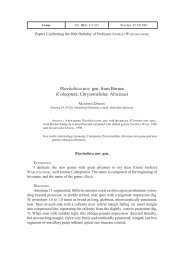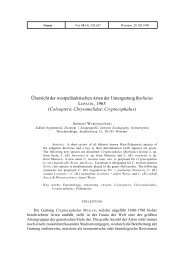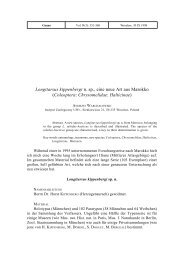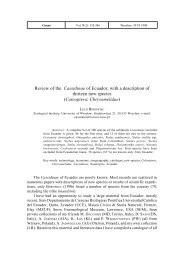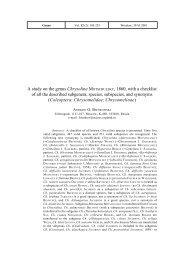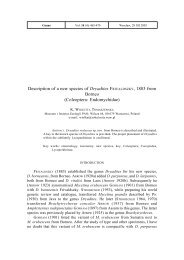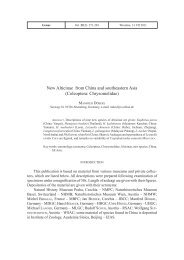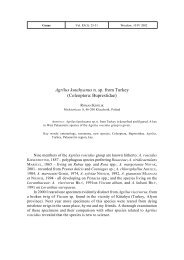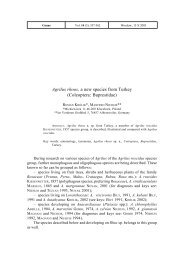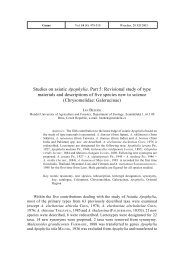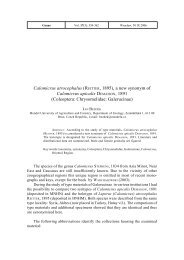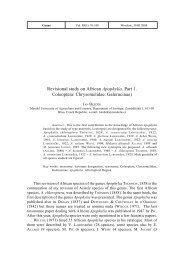New records of Asian and Australopapuan Cassidinae, with a ...
New records of Asian and Australopapuan Cassidinae, with a ...
New records of Asian and Australopapuan Cassidinae, with a ...
You also want an ePaper? Increase the reach of your titles
YUMPU automatically turns print PDFs into web optimized ePapers that Google loves.
NEW RECORDS OF ASIATIC AND AUSTRALOPAPUAN CASSIDINAE 555<br />
KEY TO THE ORIENTAL SPECIES OF CASSIDA L. WITH BLACK DISC OF PRONOTUM<br />
AND ELYTRA AND IMMACULATE EXPLANATE MARGIN<br />
1. Ventrites partly black ................................................................................ 3.<br />
-. Ventrites uniformly yellow ........................................................................ 2.<br />
2. Tarsal claws simple .................................. variablis (CHEN et ZIA, dark form)<br />
-. Tarsal claws <strong>with</strong> basal tooth ............................................................................<br />
............................... catenata (BOHEMAN) <strong>and</strong> circumdata HERBST (dark forms)<br />
3. Tarsal claws simple .................................................................................. 5.<br />
-. Tarsal claws <strong>with</strong> basal tooth or apparently appendiculate (simple but appearing<br />
appendiculate due to distally projecting flanks <strong>of</strong> the last segment <strong>of</strong> tarsi)<br />
.................................................................................................................. 4.<br />
4. Puncturation <strong>of</strong> elytra fine. Postscutellar area <strong>with</strong> indistinct H-shaped elevation.<br />
Surface <strong>of</strong> intervals <strong>with</strong> mirror lustre. Claws <strong>with</strong> basal tooth .....<br />
................................................................... australica (BOHEMAN, dark form)<br />
-. Puncturation <strong>of</strong> elytra coarse. Postscutellar area <strong>with</strong> distinct H-shaped elevation.<br />
Surface <strong>of</strong> elytra dull or glabrous but not appearing mirror-like. Claws<br />
apparently appendiculate ................................................ flavoscutata SPAETH<br />
5. Abdomen mostly black. Black on elytral disc never extending behind marginal<br />
row. Large, length above 4.6 mm ....................................................... 6.<br />
-. Abdomen yellow, at most first sternum at base <strong>with</strong> black spots. Black on<br />
elytral disc slightly extending behind marginal row. Small, length below 4.5<br />
mm ........................................................................ subprobata (CHEN et ZIA)<br />
6. Punctures in lateral rows very dense, almost touching each other. Pronotal<br />
sides narrowly rounded or angulate ............................................................ 7.<br />
-. Puncutres in lateral rows sparse, distance between them partly as wide as to<br />
slightly wider than puncture diameter. Pronotal sides broadly rounded<br />
........................................................ mroczkowskii BOROWIEC et ŒWIÊTOJAÑSKA<br />
7. Antennae uniformly yellow or only last segment in apical half infuscate ...... 8.<br />
-. At least two apical antennal segments infuscate .......................................... 9.<br />
8. Smaller, length 4.6-4.95 mm. Black on elytral disc in humeral area extending<br />
to marginal row. Abdomen narrowly surrounded by yellow, the yellow margin<br />
not wider than hind femur. Pronotal sides narrowly rounded ......................<br />
.............................................................................................. dembickyi n. sp.<br />
-. Larger, length 5.25-5.5 mm. Black on elytral disc in humeral area extending<br />
only to submarginal row. Abdomen broadly surrounded by yellow, the yellow<br />
margin distinctly wider than hind femur. Pronotal sides angulate ...........<br />
.................................................................................... chiangmaiensis n. sp.<br />
9. Postscutellar H-shaped elevation higher, central part <strong>of</strong> disc behind the<br />
postscutellar elevation <strong>with</strong> well marked folds. Anterior margin <strong>of</strong> black<br />
pronotal spot distinctly trilobate ............................................ probata SPAETH<br />
-. Postscutellar H-shaped elevation lower, central part <strong>of</strong> disc behind the<br />
postscutellar elevation <strong>with</strong>out or <strong>with</strong> indistinct folds. Anterior margin <strong>of</strong><br />
black pronotal spot not or indistinctly trilobate ...................... paiensis n. sp.



